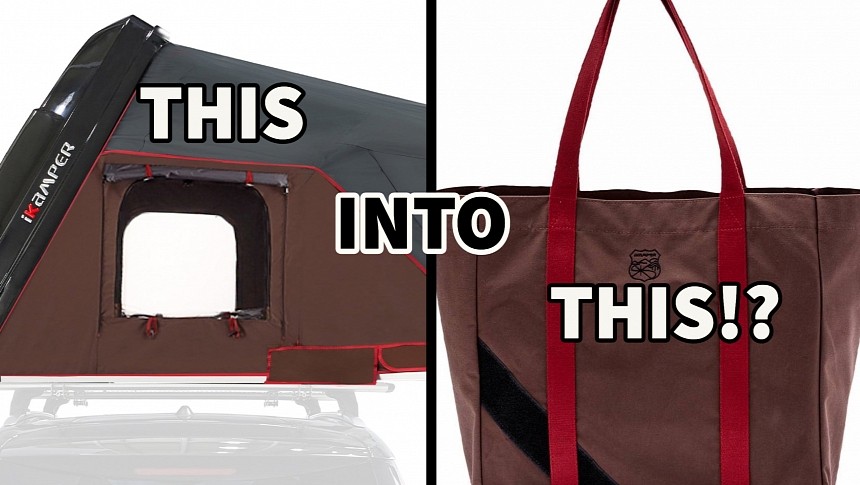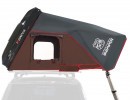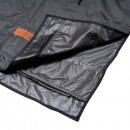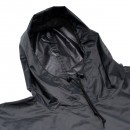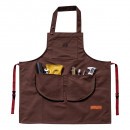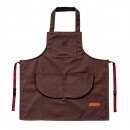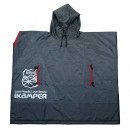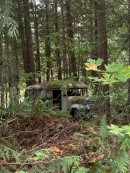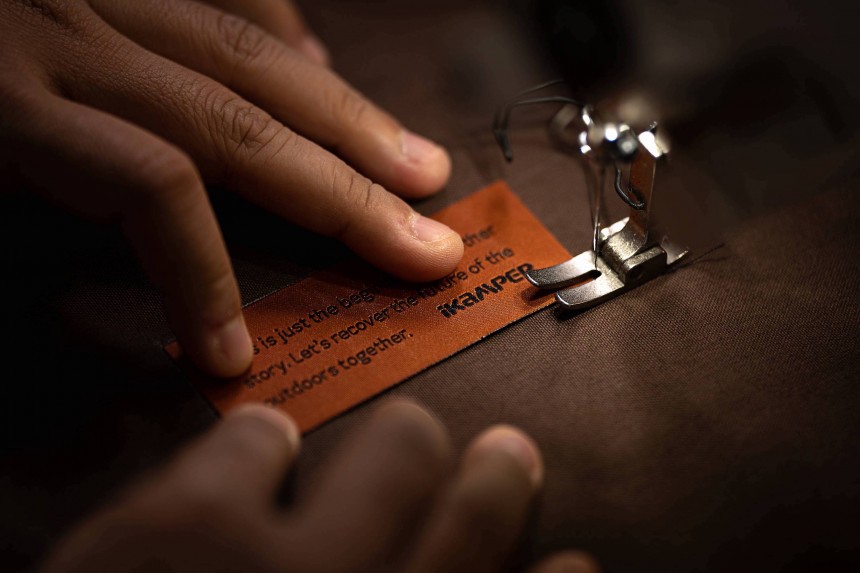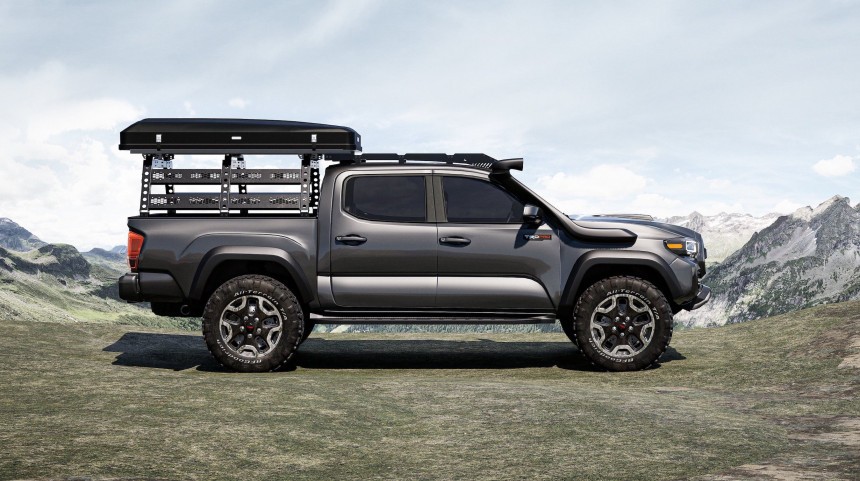We've all witnessed the growing glamping and RVing industry. But an unanswered question remains: What happens to gear and vehicles after they've pushed out their last breath? Well, iKamper is showing us one way of dealing with used goods.
Folks, the name iKamper is sure to sound familiar, as we've covered some of their glamping habitats before. In particular, their roof-top tents and on-road sleep and storage systems. This time around, however, they've unveiled the newest phase in their ever-growing outdoor-living plans, reducing materials that would otherwise end up in landfills.
It's called the ReCovery Collection, and we're looking at nothing more than yet another attempt to reduce the amount of waste the on-road living industry is shoving into landfills daily. In short, iKamper is expanding its campsite repertoire with handcrafted gear like aprons, firewood carriers, and even rain ponchos, the latter seems the most "Duh" idea possible, and you'll see why shortly. In the process, iKamper has also teamed up with other non-profit organizations to spread awareness regarding the small steps we can take to ensure our world stays as beautiful as it can be.
Now, as I explored these not-so-automotive pieces of gear, I discovered that they're all made with materials reclaimed from the production of iKamper's 365 Skycamp 2.0 roof-top tents. Why this particular model? In its production, more than one material type is present. A hard shell makes up the exterior, which isn't used in any way in the new collection, but the 300gsm poly-cotton canvas and polyester rainfly are.
Overall, three products are crafted from poly-cotton canvas, and only one is from polyester rainfly. Can you guess which ones? The first cotton good is an apron for outdoor lovers to use while whipping up their favorite meal. Because it's crafted from a material typically used on a tent camper, meaning it has to stand up to constant abuse and use, you can bet this $80 piece of hardware will fill with years of oil stains and scorch marks before laying it down to sleep. The same is true for the firewood carrier and tote bag. As for the poncho, this has to be the most "makes sense" idea yet. Why? Simply because of the material used; Skycamp's rainfly fabric is designed to keep you dry when the world is wet. This is also the most expensive of the four goods, coming in with a price of $100.
However, all this got me thinking about just how much of any camper goes to waste once it's reached the end of its rope or from the production process itself. Well, I had one hell of a hard time finding relevant information about how much waste is produced by a camper's or RV's production and lifetime.
But, what I could find is that RV manufacturers are heavily involved in reducing production waste and pollution. Even once a machine has seen its last slammed door, several teams take in old units, break them down, and reuse and recycle as much as possible. One team, R-V Industries Inc, a crew specializing in metal and industrial equipment manufacturing operating out of Philadelphia, PA, has reported a rate of recycled waste output standing at 92% for 2021, up from 89% in 2019. Lance Campers likes to use Azdel to prevent deforestation, and CNC milling to reduce sheet metal waste. Teams like America's own Winnebago and Airstream have always sought to reduce the amount of waste produced, just in different ways than iKamper. If we consider the nature of the camper and RV industries and how they're aimed at the outdoor lover, who is often a green-minded individual, all of this really makes sense.
Another wave of living that these industries have sparked is the whole zero-waste concept. For those that live in a mobile habitat for more than 20 days a year, the average time spent in an RV yearly by owners, zero-waste consciousness is something we see more and more of these days. This includes reusing containers, fabrics, and even composting. The aim of it all? To reduce our footprint on the world, which can mean more cash in your pocket, and often does.
Take that tote bag iKamper makes as a clear example of what I mean. It's currently selling for $60. On the other hand, Amazon has a seller offering 100 biodegradable bags for around $20. That's 20 cents a pop. According to sources, around 350 shopping bags are used by the average American in one year. That's a tad over $60, so buying a tote and using it for 2-3 years makes sense, especially if you care for it. Good job iKamper, for jumping in on this action.
What I'm really curious about is how manufacturers treat the bits and pieces of fiberglass, aluminum, steel, and even wood left over from production processes. Even more, what exactly happens to a camper or RV after the elements break in like the wolf from Three Little Pigs, blowing it all away with the winds of time? After all, I've seen a few ditched on the side of the road in my days. Heck, if you own an RV company, feel free to chime in with a message, and we can explore shedding some light on your upcycling methods and how you're making the world a greener place. iKamper and other teams do their part, and so should all of us.
It's called the ReCovery Collection, and we're looking at nothing more than yet another attempt to reduce the amount of waste the on-road living industry is shoving into landfills daily. In short, iKamper is expanding its campsite repertoire with handcrafted gear like aprons, firewood carriers, and even rain ponchos, the latter seems the most "Duh" idea possible, and you'll see why shortly. In the process, iKamper has also teamed up with other non-profit organizations to spread awareness regarding the small steps we can take to ensure our world stays as beautiful as it can be.
Now, as I explored these not-so-automotive pieces of gear, I discovered that they're all made with materials reclaimed from the production of iKamper's 365 Skycamp 2.0 roof-top tents. Why this particular model? In its production, more than one material type is present. A hard shell makes up the exterior, which isn't used in any way in the new collection, but the 300gsm poly-cotton canvas and polyester rainfly are.
However, all this got me thinking about just how much of any camper goes to waste once it's reached the end of its rope or from the production process itself. Well, I had one hell of a hard time finding relevant information about how much waste is produced by a camper's or RV's production and lifetime.
But, what I could find is that RV manufacturers are heavily involved in reducing production waste and pollution. Even once a machine has seen its last slammed door, several teams take in old units, break them down, and reuse and recycle as much as possible. One team, R-V Industries Inc, a crew specializing in metal and industrial equipment manufacturing operating out of Philadelphia, PA, has reported a rate of recycled waste output standing at 92% for 2021, up from 89% in 2019. Lance Campers likes to use Azdel to prevent deforestation, and CNC milling to reduce sheet metal waste. Teams like America's own Winnebago and Airstream have always sought to reduce the amount of waste produced, just in different ways than iKamper. If we consider the nature of the camper and RV industries and how they're aimed at the outdoor lover, who is often a green-minded individual, all of this really makes sense.
Take that tote bag iKamper makes as a clear example of what I mean. It's currently selling for $60. On the other hand, Amazon has a seller offering 100 biodegradable bags for around $20. That's 20 cents a pop. According to sources, around 350 shopping bags are used by the average American in one year. That's a tad over $60, so buying a tote and using it for 2-3 years makes sense, especially if you care for it. Good job iKamper, for jumping in on this action.
What I'm really curious about is how manufacturers treat the bits and pieces of fiberglass, aluminum, steel, and even wood left over from production processes. Even more, what exactly happens to a camper or RV after the elements break in like the wolf from Three Little Pigs, blowing it all away with the winds of time? After all, I've seen a few ditched on the side of the road in my days. Heck, if you own an RV company, feel free to chime in with a message, and we can explore shedding some light on your upcycling methods and how you're making the world a greener place. iKamper and other teams do their part, and so should all of us.
